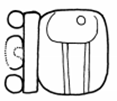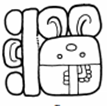![]()




K&L.p65.G4.1 = MC.p50.G4.1 K&H.p51.TabVIII.4 Gronemeyer-GGF.p6.fig5.b Gronemeyer-GGF.p6.fig5.d Gronemeyer-GGF.p6.fig5.e
DPL Stela 8 A6 NAR Stela 24 C4 TIK Stela 4 B3




K&L.p65.G4.2 = MC.p50.G4.2 Gronemeyer-GGF.p6.pdfp6.fig5.a Gronemeyer-GGF.p6.pdfp6.fig5.c Gronemeyer-GGF.p6.pdfp6.fig5.f
CPN Stela A A5 IXK Stela 2 A6 TNA Monument 175 B1
· Distinguishing characteristic is the “bar-and-dot” form of “7” + main sign:
o It can be on the left or on top of the main sign.
o It (often) has no filler(s) in between the two external dots and can be beside or above the main sign, generally:
§ Beside in the head variant
§ Above in the abstract variant
But this tendency might be an illusion caused by the small sample size.
· Gronemeyer-GGF.p6.pdfp6.fig5 has a typo where the figures are labelled a, b, c, e, f, g with accompanying text a, b, c, d, e, f for their sources – it’s safe to assume that e is actually d; f is actually e; and g is actually f
· Variants (2) of main sign:
o A. Representational – the head of a (young?) male, divided into two halves by a horizontal line at nose level:
§ Top:
· A bold semi- or 3/4- or full circle – a LEM-like element infixed in the top of the head.
· A small eye, optionally with a few tiny non-touching dots in a horizonal line to the right
§ Bottom:
· Open mouth (optionally bold lips).
· 2 vertical bars (optionally with cross-hatching in between), or just two vertical lines; alternatively, an “ajaw strap”.
· The 2 vertical lines might just be reduced/eroded forms of the 2 vertical bars and cross-hatching, or of the “ajaw strap”.
o B. Abstract:
§ Top: left and right feeler, each with its own protector. These are very common, but absent in, for example, IXK Stela 2 A6).
§ Bottom – a SIBIK-like element with boulder outline, divided into two halves by a horizontal line:
· Top half: 3 non-touching dots in a triangular formation, triangle pointing up.
· Bottom half: an element resembling an “ajaw strap”, except that the main long curved vertical band is replaced or supplemented by a slightly curved arc of touching dots.
Do not confuse the abstract variant of Glyph-G4 with the “face” variant of Glyph-G2: they both have two “leaves” (or left and right feelers with protectors) on top, but Glyph-G2 is definitely face/HAAB-like on the bottom, whereas Glyph-G4 is SIBIK-like. More importantly, Glyph-G4 always has a “7” associated with it, while Glyph-G2 never has.
· The representational and abstract variants are not as independent of one another as might initially appear. The representational variant has a SIBIK-like sub-variant (DPL Stela 8 A6, above) where:
o The infixed LEM-like element in the top of the head lacks the curved internal band of LEM and could be seen as a bolded top dot of the abstract variant.
o It has a “dotted ajaw strap”.
o The vertical bars of the bottom half could be seen as a fancy form of the vertical bar of the “ajaw strap”.